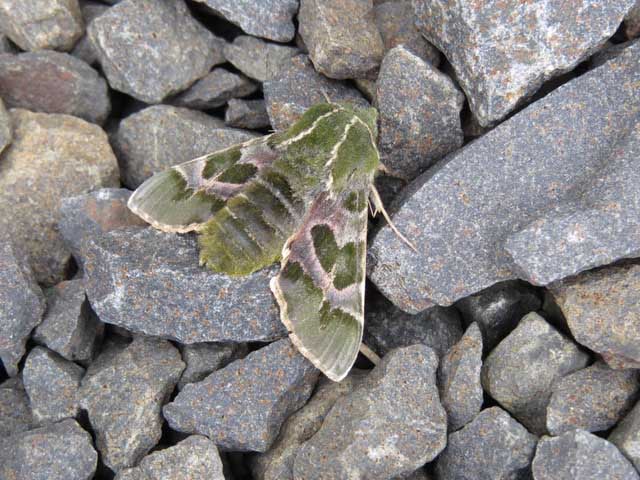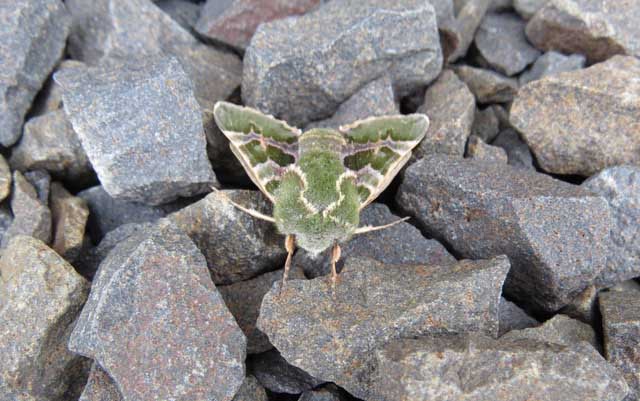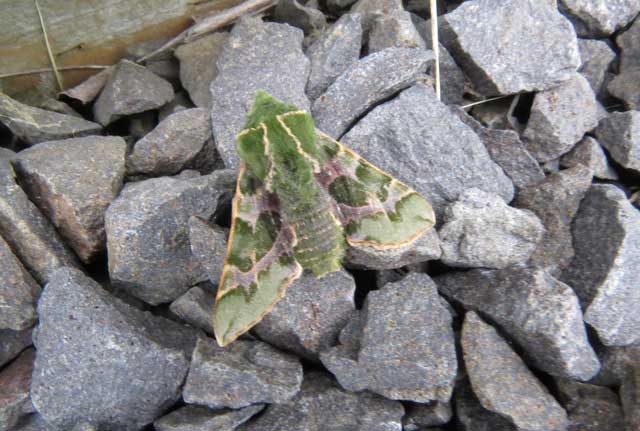Sherman County, Oregon
Sphingidae
Arctonotus/Proserpinus lucidus, Rufus, Sherman County, Oregon,
February 8, 2011, courtesy of Greg Volkman.
|
|
Updated as per James P. Tuttle's The Hawk Moths of North America, February 12, 2011 Dedicated/updated as per personal communication with Greg Volkman (Arctonotus lucidus, Rufus, February 8, 2011): February 12, 2011 Arctonotus lucidus recently (2009) assigned to the Proserpinus genus. VOLUME 63, NUMBER 4 233 Journal of the Lepidopterists’ Society 63(4), 2009, 233-235; 2018 Updated as per personal communication with Kathy Thompson (Proserpinus lucidus, February 7, 2018): February 14, 2018 |

Greg writes, February 12, 2011: "I found this little guy resting on the cold concrete with the air temperature right around freezing. I don't really think of February as being moth weather so I moved him to a sunny location on a nearby tree. I hope he recovered enough to do what he had to do. What a beautiful little animal! The wing linings were almost gold. It is a shame so many people hate insects across the board and don't think twice about using the sprays or the bug lights. I'm 53 now and I certainly don't see the numbers or the diversity I saw as a child.
"I have these and a couple other images in higher resolution if you are interested. I would be happy to send them to you."
It is hoped that this checklist, with the thumbnails and notes, will help you quickly identify the moths you have encountered.
A WO" after the species name indicates that I have no confirmed reports of this species in Sherman County, but I (William Oehlke) expect that this moth is present.
Please help me develop this list with improved, documented accuracy by sending sightings (species, date, location), preferably with an image, via email to Bill Oehlke.
It is always interesting/amazing to me that some species seem to have such regular flight periods. Twice I have received images of Arctonotus lucidus from Sherman County, Oregon: February 8, 2011, and February 7, 2018.
Kathy Thompson writes regarding Arctonotus lucidus, "About 20 or more of these hawk moths were in the gravel beneath our shop’s night light. Strange to see so many in February… but it is 62° with a light breeze."
I reply, "Thanks for sending the beautiful images and data. I suspect there may have been a freshly emerged female nearby, and males, possibly from a considerable distance, even beyond the expanse of the light, may have picked up her scent, flew towards the airborne phermone, and then got atttracted to and mesmerized by the light. It is also quite possible that you have a mix of males and females which simply responded identically to the same environmental conditions and all emerged within a couple of days of each other."

Proserpinus lucidus, Sherman County, Oregon,
February 8, 2018, Kathy Thompson

Proserpinus lucidus, Sherman County, Oregon,
February 8, 2018, Kathy Thompson

Proserpinus lucidus, Sherman County, Oregon,
February 8, 2018, Kathy Thompson
Sphinginae subfamily
Smerinthini Tribe:
Macroglossinae subfamilyDilophonotini Tribe:
Macroglossini Tribe:
proserpinus lucidus, February 8, 2018, courtesy of Kathy Thompson
|

Arctonotus lucidus, Rufus, Sherman County, Oregon,
February 8, 2011, courtesy of Greg Volkman.
Eggs of many North American species are offered during the spring and summer. Occasionally summer Actias luna and summer Antheraea polyphemus cocoons are available. Shipping to US destinations is done from with in the US.
Use your browser "Back" button to return to the previous page.
This page is brought to you by Bill Oehlke and the WLSS. Pages are on space rented from Bizland. If you would like to become a "Patron of the Sphingidae Site", contact Bill.
Please send sightings/images to Bill. I will do my best to respond to requests for identification help.
 Show appreciation for this site by clicking on flashing butterfly to the left. The link will take you to a page with links to many insect sites. |